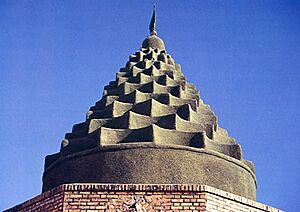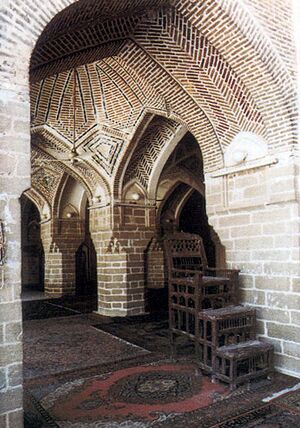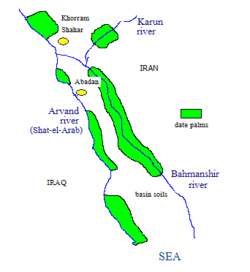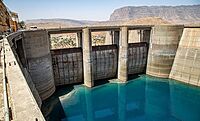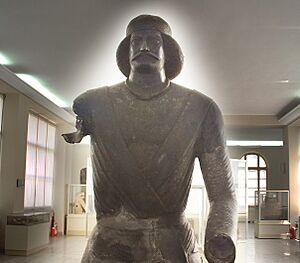Khuzestan province facts for kids
Quick facts for kids
Khuzestan Province
Persian: استان خوزستان
|
|
|---|---|
|
From the top to bottom-right, Shushtar Historical Hydraulic System, Shush Castle, Tomb of Daniel, Ziggurat in Chogha Zanbil, Ahvaz
|
|
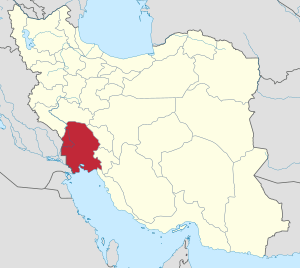
Location of Khuzestan Province within Iran
|
|
| Country | Iran |
| Region | Region 4 |
| Capital | Ahvaz |
| Counties | 30 |
| Area | |
| • Total | 64,055 km2 (24,732 sq mi) |
| Population
(2016 Census)
|
|
| • Total | 4,710,509 |
| • Estimate
(2020)
|
4,936,000 |
| • Density | 73.5385/km2 (190.4639/sq mi) |
| Time zone | UTC+03:30 (IRST) |
| ISO 3166 code | IR-06 |
| Main language(s) | Khuzestani Arabic, Luri, Persian dialects of Khuzestan , Mandaic |
| HDI (2017) | 0.802 very high · 12th |
Khuzestan Province (Persian: استان خوزستان) is one of Iran's 31 provinces. It is located in the southwest of the country. The province shares borders with Iraq and the Persian Gulf. It covers an area of about 63,238 square kilometers. The capital city of Khuzestan is Ahvaz. Since 2014, it has been part of Iran's Region 4.
In 2016, Khuzestan had a population of 4,710,509 people. This province was once a very important area in the Ancient Near East. It includes much of what was known as ancient Elam. The capital of Elam was in Susa. The name Khuzestan means "the Land of the Khuz." This refers to the original people of the province, called the "Susian" people.
For most of its history, the capital of Khuzestan was in the northern part. First, it was Susa (Shush), then Shushtar. Later, during the Sasanian era, the capital moved to Hormuz-Ardasher. This city was built by Ardashir I in the 3rd century CE. Today, this city is known as Ahvaz. However, the capital moved back to Shushtar and stayed there until the late Qajar period.
As international sea trade grew, Ahvaz became a better location for the capital. The Karun River is easy to travel on by boat all the way to Ahvaz. The Qajar king, Naser al-Din Shah, rebuilt the town and named it Nâseri. Shushtar then became less important, while Ahvaz/Nâseri grew into the busy city it is today.
Khuzestan is known for its many different groups of people. The population includes Lurs, Iranian Arabs, Qashqai people, Afshars, local Persians, Kurds, and Iranian Armenians. Most people in Khuzestan are Shia Muslim. There are also smaller groups of Christians, Jews, Sunni Muslims, and Mandeans. About half of Khuzestan's population is Lur.
Contents
Understanding the Name Khuzestan
The name Khuzestan means "The Land of the Khuzi." It refers to the first people who lived in this province, the "Susian" people. In Old Persian, they were called "Huza." In Middle Persian, the name became "Khuzi" or "Husa." The city of Ahvaz also gets its name from the Khuzis. Its old name was "Suq al-Ahvaz," meaning "Market of the Huzis."
The entire province was called "the Khudhi" or "the Khooji" until the 16th century. The southern part of the province was later known as Arabistan. The northern part kept the name Khuzestan. In 1925, the whole province went back to its old name, Khuzestan.
There is also a folk story about the name. It says "khouz" means sugar and "Khouzi" means people who make raw sugar. This province has been growing sugar cane since ancient times. You can still find sugar cane fields in places like Haft Tepe. The name of the province in Syriac is Beth Huzaye.
A Look at Khuzestan's Past
Ancient Times: A Cradle of Civilization
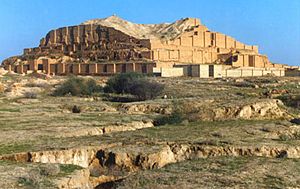
Khuzestan is one of the oldest places where civilization began. It was a very important region in the Ancient Near East, centered around Susa. The first major empire here was that of the powerful Elamites around 4000 BC.
Archaeological findings show that Khuzestan was home to the Elamite civilization. These people did not speak Semitic or Indo-European languages. They were "the earliest civilization of Persia." The name Khuzestan comes from the Elamite word ʰŪvja.
In 640 BC, the Elamites were defeated by Ashurbanipal. Their cities, Susa and Chogha Zanbil, were destroyed. But in 538 BC, Cyrus the Great took back the Elamite lands. Susa became one of the Achaemenid capitals. Darius the Great built a large palace called Apadana there in 521 BC. This golden age ended with the conquests of Alexander the Great.
After Alexander, the Seleucid dynasty ruled the area. As they became weaker, Mehrdad I of Parthia took control. During the Sassanid dynasty, this area grew a lot. Many buildings were put up in Ahvaz, Shushtar, and north of Andimeshk.
The Academy of Gundishapur was a famous center for science and culture. It brought together doctors from Egypt, the Byzantine Empire, and Rome. This shows how important and successful this region was. The Jondi-Shapur Medical School was founded by Shapur I.
Muslim Conquest and Later Rule
The Muslim conquest of Khuzestan happened in 639 AD. Abu Musa al-Ash'ari led the army from Basra. He drove out the Persian governor, Hormuzan, from Ahvaz. Susa also fell, and Hormuzan fled to Shushtar. Abu Musa's army surrounded Shushtar for 18 months. Shushtar finally fell in 642 AD.
After the Muslim conquest, Khuzestan came under the rule of the Umayyad and Abbasid Caliphates. Later, Ya'qub bin Laith as-Saffar from southeastern Iran started a new Iranian dynasty, the Saffarids. They took control of Khuzestan and other parts of Iran. From then on, Iranian dynasties continued to rule the region.
During the Umayyad period, many Arab tribes moved from across the Persian Gulf to areas around Ahvaz and Fars. In the 10th century, during the Abbasid period, the Assad tribe also moved into Khuzestan. Later, in the 16th century, the Bani Kaab tribe from Kuwait settled in Khuzestan. More Arab tribes moved from southern Iraq to Khuzestan in the centuries that followed.
Modern History: Changes and Challenges
Under the Qajar dynasty, the southern part of Khuzestan was known as Arabistan. The northern parts, with the capital at Shushtar, kept the old name. Sometimes, the northern part was also linked to the Greater Lur region because of the large Bakhtiari population.
In 1856, during the Anglo-Persian War, British naval forces sailed up the Karun river to Ahvaz. However, they left the province after the war ended.
Pahlavi Era
Before 1925, the western part of Khuzestan was like an independent area called "Arabistan." The eastern part was ruled by Bakhtiari leaders. In 1925, the government of Reza Shah ended this independent rule. This was part of a plan to make the country more centralized. The western part's leader, Sheikh Khazal, started a rebellion, but it was quickly stopped.
The name 'Khuzistan' was used for the whole area by 1936. During the Pahlavi rule, Khuzestan remained important for its economy and defense.
Islamic Republic Era
After the Iranian Revolution in 1979, there were some local uprisings. In April 1979, an uprising happened in Khuzestan. It was led by an Arab separatist group.
The Iranian Embassy siege in London in 1980 was linked to this group. They wanted more control for Khuzestan. However, their ties to Baghdad made people question if they were truly an Iranian opposition group.
Iran–Iraq War
During the Iran–Iraq War, Khuzestan was the main target of Iraq's invasion. Many people had to leave their homes. Khuzestan suffered the most damage of all Iranian provinces during the war. Iraq's leader, Saddam Hussein, thought the Arab people of Khuzestan would welcome his army. But the people fought back strongly. This gave Iran a chance to fight back.
Iran's largest oil refinery in Abadan was destroyed. Many famous palm groves were ruined, cities were destroyed, and historical sites were damaged. Almost half the province was taken by the Iraqi army. This caused many people to become refugees in other provinces.
By 1982, Iranian forces pushed the Iraqi army out of Iran. The Battle of Khorramshahr was a turning point in the war. It is celebrated every year in Iran. The city of Khorramshahr was almost completely destroyed.
Recent Events
In 2005, Ahvaz had some bombings after the Ahvaz riots. In 2011, there was another wave of protests by Arab tribes in Ahvaz. Before the Iran–Iraq War, most Arabs in Khuzestan lived in rural areas. After the war, many moved to cities. This change in lifestyle caused some problems and unrest. In June 2022, a building collapsed in Khuzestan, leading to protests.
Geography and Weather
Khuzestan province has two main areas. In the north, there are rolling hills and mountains. To the south, there are plains and marsh lands. Rivers like the Karoun, Karkheh, Jarahi, and Maroun flow through the area. These rivers help irrigate the land.
Khuzestan has great potential for farming. Large rivers flow through the area, making the land fertile. The Karun is Iran's longest river, at 850 kilometers. It flows into the Persian Gulf through this province. However, some rivers carry salt, especially as they flow away from the mountains. If the "Salty River" (Rud-i Shur) could be moved away from the Karun, the Karun's water would be much fresher.
The weather in Khuzestan is usually very hot. It can be humid, especially in the south. Winters can be cold and dry. Summer temperatures often go above 45°C (113°F) daily. In winter, it can drop below freezing, and sometimes it snows in the mountains. Khuzestan is one of the hottest places on Earth. Temperatures can sometimes reach over 50°C (122°F). Khuzestan also has desert conditions and often experiences sandstorms.
Administrative Divisions
 Khuzestan Province is divided into many counties. The table below shows how the population of these counties has changed over time.
Khuzestan Province is divided into many counties. The table below shows how the population of these counties has changed over time.
| Counties | 2006 | 2011 | 2016 |
|---|---|---|---|
| Abadan | 275,126 | 271,484 | 298,090 |
| Aghajari | — | — | 17,654 |
| Ahvaz | 1,317,377 | 1,395,184 | 1,302,591 |
| Andika | — | 50,797 | 47,629 |
| Andimeshk | 154,081 | 167,126 | 171,412 |
| Bagh-e Malek | 103,217 | 107,450 | 105,384 |
| Bavi | — | 89,160 | 96,484 |
| Behbahan | 172,597 | 179,703 | 180,593 |
| Dasht-e Azadegan | 126,865 | 99,831 | 107,989 |
| Dezful | 384,851 | 423,552 | 443,971 |
| Dezpart | — | — | — |
| Gotvand | 58,311 | 64,951 | 65,468 |
| Haftkel | — | 22,391 | 22,119 |
| Hamidiyeh | — | — | 53,762 |
| Hendijan | 35,932 | 37,440 | 38,762 |
| Hoveyzeh | — | 34,312 | 38,886 |
| Izeh | 193,510 | 203,621 | 198,871 |
| Karkheh | — | — | — |
| Karun | — | — | 105,872 |
| Khorramshahr | 155,224 | 163,701 | 170,976 |
| Lali | 35,549 | 37,381 | 37,963 |
| Mahshahr | 247,804 | 278,037 | 296,271 |
| Masjed Soleyman | 167,226 | 113,257 | 113,419 |
| Omidiyeh | 85,195 | 90,420 | 92,335 |
| Ramhormoz | 120,194 | 105,418 | 113,776 |
| Ramshir | 49,238 | 48,943 | 54,004 |
| Seydun | — | — | — |
| Shadegan | 138,226 | 153,355 | 138,480 |
| Shush | 189,793 | 202,762 | 205,720 |
| Shushtar | 182,282 | 191,444 | 192,028 |
| Total | 4,192,598 | 4,531,720 | 4,710,509 |
Cities of Khuzestan Province
In 2016, over 75% of Khuzestan's population lived in cities. Here are some of the main cities:
| City | Population |
|---|---|
| Abadan | 231,476 |
| Abezhdan | 1,673 |
| Abu Homeyzeh | 5,506 |
| Aghajari | 11,912 |
| Ahvaz | 1,184,788 |
| Alvan | 6,860 |
| Andimeshk | 135,116 |
| Arvandkenar | 11,173 |
| Azadi | 4,957 |
| Bagh-e Malek | 26,343 |
| Bandar-e Emam Khomeyni | 78,353 |
| Bandar-e Mahshahr | 162,797 |
| Behbahan | 122,604 |
| Bidrubeh | 2,386 |
| Bostan | 8,476 |
| Cham Golak | 5,446 |
| Chamran | 33,505 |
| Chavibdeh | 7,906 |
| Choghamish | 2,013 |
| Darkhoveyn | 5,655 |
| Dehdez | 5,490 |
| Dezful | 264,709 |
| Elhayi | 7,651 |
| Fath Olmobin | 2,973 |
| Golgir | 1,089 |
| Gotvand | 24,216 |
| Guriyeh | 2,890 |
| Haftkel | 15,802 |
| Hamidiyeh | 22,057 |
| Hamzeh | 6,091 |
| Hendijan | 29,015 |
| Horr | 9,177 |
| Hoseyniyeh | 1,821 |
| Hosseinabad | 8,833 |
| Hoveyzeh | 19,481 |
| Izeh | 119,399 |
| Jannat Makan | 5,360 |
| Jayezan | 2,357 |
| Khanafereh | 3,853 |
| Khorramshahr | 133,097 |
| Kut-e Abdollah | 56,252 |
| Kut-e Seyyed Naim | 4,541 |
| Lali | 18,473 |
| Mansuriyeh | 5,441 |
| Masjed Soleyman | 100,497 |
| Meydavud | 3,513 |
| Mianrud | 10,110 |
| Minushahr | 2,231 |
| Mollasani | 17,337 |
| Moshrageh | 2,095 |
| Omidiyeh | 67,427 |
| Qaleh Tall | 10,698 |
| Qaleh-ye Khvajeh | 2,408 |
| Rafi | 3,797 |
| Ramhormoz | 74,285 |
| Ramshir | 25,009 |
| Safiabad | 9,879 |
| Saland | 2,560 |
| Saleh Shahr | 7,309 |
| Sardarabad | 5,240 |
| Sardasht | 6,912 |
| Seydun | 7,650 |
| Shadegan | 41,733 |
| Shahr-e Emam | 11,393 |
| Shamsabad | 10,858 |
| Sharaft | 11,757 |
| Sheyban | 36,374 |
| Shush | 77,148 |
| Shushtar | 101,878 |
| Siah Mansur | 5,406 |
| Somaleh | 1,784 |
| Susangerd | 51,431 |
| Tashan | 4,281 |
| Torkalaki | 5,688 |
| Veys | 15,312 |
| Zahreh | 1,192 |
People and Culture of Khuzestan
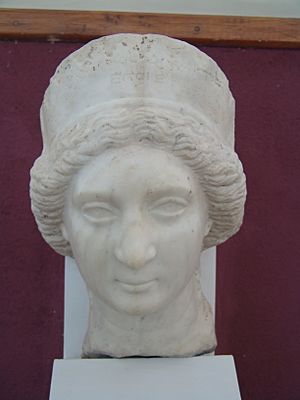
In 2016, Khuzestan had about 4.7 million people. Most of them lived in cities. Khuzestan is home to many different groups of people. These include Persians, Arabs, Bakhtiaris, Lurs, Qashqai people (from the Afshar tribe), Mandaeans, and Armenians.
A study in 2010 found that the population of Khuzestan was made up of:
- Arabs: 33.6%
- Persians: 31.9%
- Lurs: 30%
- Turkish speakers: 2.5%
- Kurds: 1%
- Other groups: 0.7%
Khuzestan in Literature
Khuzestan has often been written about by Persian writers and poets. Because of its large sugar production, the word "sugar" from Khuzestan was used to mean sweetness. Here are some examples: "Her lips aflow with sweet sugar, The sweet sugar that aflows in Khuzestan." Nizami
"Your graceful figure like the cypress in Kashmar, Your sweet lips like the sugar of Khuzestan." Nizari Qohistani
Languages Spoken in Khuzestan
Besides Persian, other languages and dialects are spoken in Khuzestan. Many people speak Arabic (specifically Khuzestani Arabic). Another group speaks the Bakhtiari dialect. A very small number of older Mandaeans speak Neo-Mandaic.
Traditions and Beliefs
Most people in Khuzestan are Shia Muslims. There are also smaller groups of Sunni Muslims, Jews, Christians, and Mandaeans. People from Khuzestan are known for being very welcoming and generous.
Delicious Khuzestani Food
Seafood is a very important part of Khuzestani food. One popular dish is Ghalyeh Mahi. This is a fish dish made with strong spices, onions, and cilantro. The fish used is called mahi soboor (shad fish), found in the Persian Gulf. Other local dishes include Ghalyeh Meygu (shrimp casserole) and kohbbeh (a deep-fried rice cake with ground beef).
Famous People from Khuzestan
Many important scientists, thinkers, and poets have come from Khuzestan. These include Abu Nuwas (a poet), Nowbækht-e Ahvazi (an astronomer), and Sheikh Mortedha Ansari (a famous Shia scholar).
Khuzestan's Economy
Khuzestan is Iran's main oil-producing region. This makes it one of the richest provinces in Iran. Khuzestan ranks third among Iran's provinces in its total economic output (GDP).
In 2005, Iran announced plans to build its second nuclear reactor in Khuzestan. This reactor will produce 360 megawatts of power.
Khuzestan is also home to the Arvand Free Trade Zone. This is one of Iran's six special economic zones. Another one is the PETZONE (Petrochemical Special Economic Zone) in Mahshahr.
Shipping and Rivers
The Karun River is the only river in Iran that ships can travel on. In the past, the British used the Karun to transport goods. They sailed up to Langar near Shushtar and then moved goods by road. The Karun can be used by fairly large ships up to Shushtar.
Many other rivers and water sources are in this region. These include Karkheh, Jarrahi, Arvandrood, and Dez. All these water sources make the region great for growing many different farm products.
Farming in Khuzestan
Plenty of water and fertile soil make Khuzestan a rich farming area. Many types of crops grow here, such as wheat, barley, oilseeds, rice, and eucalyptus. There are also many palm and citrus farms. Mountains nearby are good for growing olives. And, of course, sugar cane grows here, which is how Khuzestan got its name. In 2005, 51,000 hectares of land grew sugar cane, producing 350,000 tons of sugar. The many rivers and dams also support the fishing industry in the area.
Abadan island is important for growing datepalms. These palm groves are watered by tidal irrigation. When the tide is high, river water flows into irrigation canals. When the tide is low, the canals drain the extra water back to the river.
Industries in Khuzestan
There are several cane sugar mills in Khuzestan Province, like Haft Tepe and Karun Agro Industry near Shushtar.
The Karun 3 and 4, and Karkheh Dam, along with oil reserves, provide Iran with money and energy. Khuzestan also has major industries like petrochemicals, steel, pipe making, power stations, and large refineries.
Oil Resources
Khuzestan is home to the Yadavaran Field, a very large oil field. Khuzestan holds 80% of Iran's oil reserves found on land. This means it has 57% of Iran's total oil reserves. This makes Khuzestan extremely important to Iran's economy.
Khuzestan and the Iran-Iraq War
From September 22, 1980, until the end of the Iran-Iraq War, Khuzestan was a major battleground. Cities like Abadan, Susangerd, Bostan, Dezful, Andimeshk, Khorramshahr, and Ahvaz were often attacked by Iraqi rockets and artillery.
Khuzestan suffered a lot of damage during the war. Some areas were occupied for a long time. Constant bombing and attacks on cities caused great harm to the province's natural resources and its people.
After the War
After the war ended, the province's growth and development were very slow. Even though Khuzestan has many natural resources, like oil, it faces many problems. These include high unemployment, water shortages, dust storms, and a lack of basic services. These issues have led to protests from the people of the province.
Higher Education in Khuzestan
Khuzestan has many universities and colleges. These include:
- Khorramshahr University of Nautical Sciences and Technologies
- Ahvaz Jundishapur University of Medical Sciences
- Petroleum University of Technology
- Shahid Chamran University of Ahvaz
- Islamic Azad University, Ahvaz Branch
- Amirkabir University of Technology, Mahshahr campus
Amazing Places to Visit in Khuzestan
Iran National Heritage Organization lists 140 historical and cultural sites in Khuzestan. This shows how old and important the province is. It was once the center of Iran's oldest empire.
Some popular places to visit include:
- Choqa Zanbil: This was the main city of the Elamite Empire. It has a magnificent five-story temple called a ziggurat. It is one of the greatest ancient buildings in the Middle East. The temple was built to honor Inshushinak, the god who protected the city of Susa.
- Shush-Daniel: This is believed to be the burial place of the Jewish prophet Daniel. He is said to have died in Susa. The tomb of Ya'qub bin Laith as-Saffar, who fought against the Umayyad Caliphate, is also nearby.
- Dezful (Dezh-pol): Its name comes from a bridge (pol) over the Dez river. This bridge has 12 arches and was built by Shapur I.
- Shushtar: This city is home to the famous Shushtar Watermills. It is one of Iran's oldest fortress cities. In and around Shushtar, you can see many examples of ancient water engineering. There are also the Band Mizan and Band Qeysar, which are 2000-year-old dams on the Karoun river. The famous Shadervan Bridge is also over 2000 years old.
- Izeh: Also known as Izaj, this city was a target during the Islamic conquest of Persia. The Kharezad Bridge, a very unusual bridge, was located here. The brass statue of The Parthian Man, found here, is now in the National Museum of Iran.
- Masjed Soleyman: This ancient town has old fire altars and temples. It is also where the Bakhtiari tribe rests in winter. This is also where William Knox D'Arcy dug Iran's first oil well.
- Abadan: It is said that the tomb of Elijah, the Hebrew prophet, is here.
See Also
- Ahvaz
- Andimeshk
- Shushtar
- Susa
- Choqa Zanbil
- Rahian-e Noor
- Muslim conquest of Khuzestan
- Muslim conquest of Persia
- Origin of the name Khuzestan
- Mesopotamian Marshes
- The Ascetical Homilies of Isaac the Syrian
- Tidal irrigation in Abadan Island







